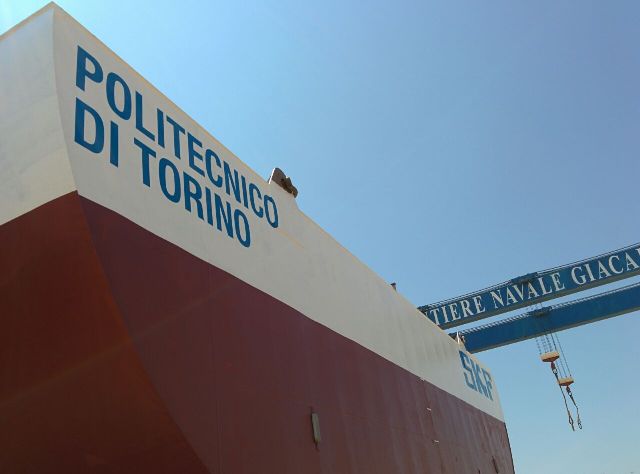Aug 7 2015
The Politecnico di Torino and the spin off Wave for Energy have developed the first Italian 1:1 scale device for the production of electricity from sea waves which, on August 7th, will be moored 800 m from the coast of Pantelleria.
The research activities, started 10 years ago and conducted by the group led by Giuliana Mattiazzo and Ermanno Giorcelli from the Department of Mechanical and Aerospace Engineering at the Politecnico di Torino, led to the development of the technology industrialized by Wave for Energy, spin-off of the University, which carried forward the construction of the first pre-commercial machine.
 energia moto ondoso2
energia moto ondoso2
The project stems from the awareness of the enormous potential of waves as a source of renewable energy, thanks to the continuity and availability of oceans in the globe. The power, usually expressed per unit length of the wave front, ranges from 25 kW / m in Southern Europe (Canary Islands), up to 75 kW / m of the Irish and Scottish coasts. Even in the Mediterranean Sea the available power is significant and is between 4 and 11 kW / m. Extracting only 5% of the technical potential of the resource available in Europe (320 GW), the energy from waves could provide electricity to 12 million homes.
The technology, developed following the directives of the Blue Growth Strategy set out by the European Commission to support sustainable development in the maritime sector, is called ISWEC (Inertial Sea Wave Energy Converter). After the first concept developed in 2006, experimental validation followed and was carried on with a 1: 8 system and conducted in the INSEAN’s towing tank. In February 2012 the team started the work on the final full scale release, which is now ready for the deployment into the sea.
The wave power plant is composed of a gyroscopic group housed inside a watertight mono-hull vessel secured to the sea floor by a slack mooring line. The interaction between the sea waves, the hull and the gyroscopic system inside enables the generation of electricity, which can be then transferred to the grid.
Thanks to the collaboration with the ENEA’s group directed by Gianmaria Sannino, within the “Sistema Elettrico” research framework, the most suitable installation site has been identified. This element will enable the system to adapt to changing climatic characteristics optimizing the overall productivity. Compared to other systems under development in Europe, ISWEC is distinguished by the absence of parts in relative motion immersed the water, as the whole conversion group is allocated in a sealed environment inside the floating body. Furthermore, the device does not require fixed constraints on the seabed for its operation, but only a slack mooring, guaranteeing an extremely reduced environmental impact. Finally, the adaptability to changing wave conditions increases the productivity of the system in respect to competitors.
The system has overall dimensions of 8 m width, 15 m length and 4.5 m height, a draft of 3.2 m and emerges 1.3 m from the sea surface. It will be moored at a distance of about 800 m from the shore and at 35 m depth in the northwest side of the island.
In the first operating phase, the system will not be connected to the island’s grid, but it will dissipate over an array of resistances. In September / October an electric cable will be layd down to connect the machine to the grid.
The ISWEC system will produce electricity at a more competitive price than the one required to produce electricity on the island of Pantelleria. Since today, this technology is a valuable complement to the energy mix of smaller islands, within and outside the Mediterranean, and which are not directly connected to the main continental grids.
Thanks to a design and industrial optimization process, the research team from the Politecnico di Torino and the team from Wave for Energy aim to bring the cost of producing electricity from waves with the ISWEC system in grid parity, the point at which the electricity produced from renewable sources achieves the same price of energy from traditional sources, in order to become a new sustainable source of renewable energy.
Enea and IAMC from Capogranitola conducted activities related to the environmental impact assessment. Enea was responsible for the mapping of Posidonia before and after the installation, while CNR, with the research group coordinated by Giuseppa Buscaino, made the noise and environmental impact analysis of the device.
The development of the project was possible thanks to the funding obtained from the Piedmont (Enermhy pole) and Sicily Regions and to the collaboration with ARIS spa, Landra S.r.l., UP Design s.r.l, Sirius Electronic System s.r.l., Miwt s.r.l., Power Evolution s.r.l., università di Catania, Asa impianti s.r.l., as well as the support in the development stages of Remacut s.r.l., SKF, SIEMENS e NATIONAL INSTRUMENTS and the crucial contribution of the administration and the community of the island of Pantelleria.